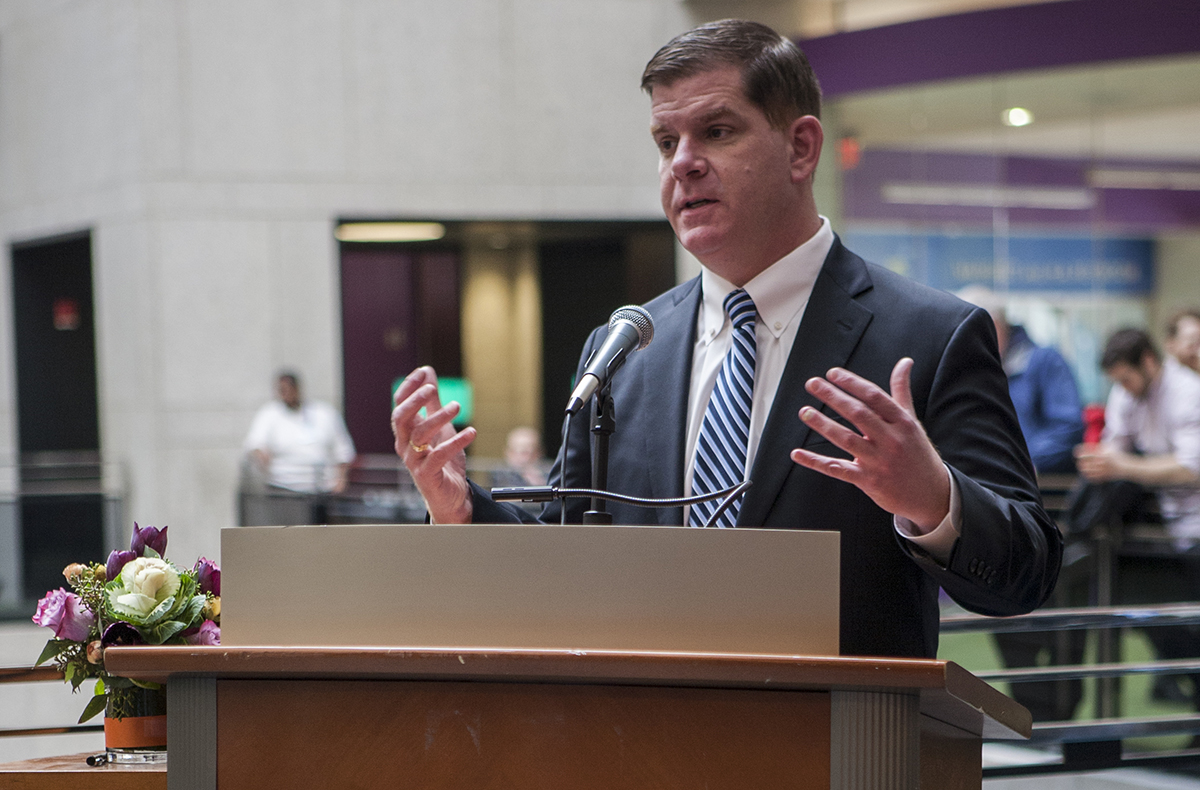Optimism and Concern as Official Boston Creates Plan Is Unveiled

Mayor Marty Walsh Photo by Olga Khvan
It’s just a beginning.
That’s what Mayor Marty Walsh said last month when he unveiled Boston Creates, the city’s newly minted ten-year cultural plan that aims to do nothing short of transform the city into a municipal arts Mecca. His announcement touted “more than $1 million” in new arts funding and a string of new initiatives.
But the plan’s lofty goals seem likely to involve significantly more money. “More than $1 million” sounds good, but it’s not a lot of meatballs, given the ambitious scope of the plan. And there are a lot of questions about the specifics. So how much of the announcement was window dressing?
The lengthy planning process had its ups and downs, with an air of excitement at the beginning and widespread frustrations near the end. Members of the arts community criticized a draft of the plan that was released in May. Hundreds made public comments on the draft document, some positive, some negative, but the city has removed the online comments from the document.
After the mixed response, the city got busy. The announcement of the final plan was unveiled with great fanfare at the Americans for the Arts Convention by Mayor Walsh himself in June—along with Chief of Arts and Culture Julie Burros. The plan wasn’t all that different from the draft, but the city did come up with some implementation steps aimed to address the community’s concerns.
Some of the highlights:
- The city will launch a new percent-for-art program. It will leverage the city’s Five Year Capital plan, which borrows money for infrastructure projects, and devote one percent of the annual anticipated borrowed funds to install public art projects at or near new city-funded projects, such as libraries, schools, and parks.
- The city is launching an Alternative Spaces Program, which will identify underused private spaces to be used for rehearsals and performances. Three organizations have signed on: Massachusetts Eye and Ear, AT&T’s Boylston Street store, and the Plumbers Local 12 Union. The city’s Office of Arts and Culture will help develop a request for proposal for organizations to apply to use these spaces for one year.
- The Boston Housing Authority will set aside low-income housing for artists in redevelopments.
- The city landed its first corporate partner with a grant from Eastern Bank to support the Boston Cultural Council.
- The Boston Foundation launched Catalyze Creativity, a pooled fund that will offer grants of up to $15,000 to small dance and theater groups. It will provide $1.5 million over three years, and the Barr Foundation will kick in $250,000 during the first year.
- EdVestors, a Boston education philanthropy, is making $680,000 in new grants through its Boston Public Schools Arts Expansion Fund, which supports arts instruction for BPS students.
That’s a long way from the draft released in May, which had few specifics and no money attached. The folks at City Hall clearly got busy dialing for dollars, which is a good thing.
But how does it add up?
First, the money. Ever since the process began, folks have been citing the need for corporate sponsors to support the plan. Eastern Bank deserves major kudos for stepping up, particularly since it focuses its charity on social services and community issues. It typically gives small grants ranging from $50 to $50,000 in order to support organizations serving needy and underserved communities. But while championing its “first corporate partner,” the city left out the amount of the grant, which is for $2,500. To be clear: Eastern Bank is a leader and it deserves all the applause it got at the mayor’s announcement. But when City Hall was seeking partners in the weeks after the draft plan was released, what about other corporations? What about General Electric, which received healthy financial breaks when Walsh courted the conglomerate to come to town?
Certainly, the Boston Foundation grants to small performance troupes are significant for bootstrap organizations. The money will have a huge impact for the city’s dance and theater troupes, many of which operate as a labor of love. And the percent-for-art program is a start; it would have amounted to about $1.4 million in fiscal year 2016. But the plan is in its pilot stage and won’t be rolled out fully until fiscal year 2018 — and who knows what will happen to the city budget in the interim.
And the plan does not include a dedicated municipal revenue stream—such as a hotel tax or a cigarette tax—to support the arts, an issue that came up at every level of the planning process. Boston ranks last in the list of the top ten cities in municipal funding for the arts, despite its world-class institutions. The need for a dedicated revenue stream was at the top of everyone’s list during the entire 18-month process.
The artist housing announcement is also a start—but only ten eligible artists will win prized affordable housing at a new mixed-income community in Charlestown. The mayor says the BHA will continue to set aside housing in its developments, but the arrangement does not extend to private developers.
As for the partnerships, the plan to open up private space for performance groups is innovative. But some of the other programs announced were already in the works independent of the planning process and would have happened anyway, Boston Creates or no Boston Creates. For instance, the deadline for the EdVestors grant application was in March, long before the Boston Creates plan was released. EdVestors has been working with BPS since 2009.
And how do we know that Boston Creates will actually be implemented? The city has yet to come up with a way to monitor success. The plan does call for the city to form an accountability body that is independent of city government. Burros was instrumental in the creation of a similar plan in Chicago in 2012. But it wasn’t until two years later—after questions about implementation—that an independent group called Accelerate Culture was formed to promote and monitor the progress of that city’s plan. How will Boston chart success—or shortcomings—one year, five years, and ten years down the road?
The initial announcements seemed exciting as the mayor ticked them off. But some of it is certainly window dressing, with projects that already existed wrapped up in the Boston Creates bow.
And that’s why the word on the street is decidedly mixed — and why many in the arts community won’t comment publicly. Artists and organizations that stand to get grants, housing or performance space are thrilled, as they should be. But others are wondering why the partnerships and financial arrangements weren’t integral to the planning process from the outset.
The mayor, of course, says this is only a beginning. “If all we got out of this was a plan, we would have squandered an opportunity,’’ he said. Exactly.


